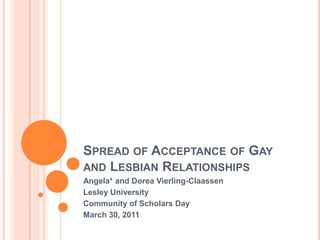
Spread of Acceptance of Gays and Lesbians
- 1. Spread of Acceptance of Gay and Lesbian Relationships Angela* and Dorea Vierling-Claassen Lesley University Community of Scholars Day March 30, 2011
- 2. Acceptance of Homosexuality According to Gallup polls, the percentage of Americans who believe it is “morally acceptable” to be gay or lesbian has risen from 40% to 52% over the last 10 years. What is driving the increasing acceptance levels? One factor is relationships – a relationship with a gay or lesbian person interacts with a person’s prior beliefs and attitudes and is a powerful force to change one mind a time. How can math help us understand this? We can use math to model human interactions and social networks.
- 3. Complex Networks In recent years, there has been an explosion of interest in complex networks, which can model Social networks, such as friendships or collaborative networks Food webs, neural networks, and other biological networks The internet, power grids, subway systems, and other constructed networks Complex networks have an irregular structure. Evolve dynamically in time General trend is to move from considering small networks to networks with thousands or millions of nodes.
- 4. Networks: the Math Mathematically, networks are graphs, which are made up of nodes and edges Once we have a graph, we can talk about characteristics of nodes and of the graph as a whol
- 5. Characteristics Degree of a node, which means a nodes total number of neighbors (other nodes connected to it by an edge) Clustering coefficient – how likely are two neighbors of any node to be neighbors of each other (do my friends know each other?)
- 6. Nodes can have attributes
- 7. Edges can have attributes
- 8. Modeling Acceptance We start by assigning each node a random level of acceptance between 0 and 1, with higher numbers being more accepting. We reserve an acceptance level of 1 to indicate that a node is gay or lesbian. Over time, we allow interactions between the nodes to change the acceptance level of the nodes. However, gay and lesbian nodes always have an acceptance level of 1. Edges between nodes are classified as “friend” or “family”
- 9. How Minds are Changed Randomly select a node N and friend or family member F. If the acceptance levels of N and F are close enough to each other, both N and F move closer to their average level. If the acceptance level is too far apart, the relationship is severed, the edge is removed, and N is randomly assigned a new friend by creating a new edge.
- 10. Some Notes Family ties are harder to break that friend ties (they will tolerate a larger degree of difference)
- 11. What Happens Over Time (3000 steps) Start End
- 12. Evolution of Queer vs. Straight Ties Connections between gay nodes Connections between similar collection of straight nodes.
- 13. Impact of Non-Acceptance When the average network acceptance level is low, gays and lesbians cluster into communities that are somewhat separate from straight communities
- 14. Impact of Non-Acceptance Such networks end up having two separate clusters – queers and straights Queers are highly connected with other queers Queers have fewer total connections (because many straight people have broken ties)
- 15. Impact of Weak Ties If all ties are easy to break, network becomes more unaccepting over time
- 16. Impact of Strong Ties Having strong ties (such as family ties) that resist breaking leads to a more accepting network over time. This is true even if network is unaccepting to begin with.
- 17. Networks which Include Acceptance Here, all ties are relatively easy to break. The same phenomena occurs when we include family ties (harder to break).
- 18. Impact of Family Ties Increasing the number of ties that are difficult to break will pull the network toward more acceptance. However, if a network starts out unaccepting, then even when it eventually becomes more accepting the clustering of gay people persists in this model.
- 19. Preliminary Conclusions Ties that are difficult to break change the overall acceptance level, so keep those ties! Counteracting the clumping effects and social isolation of queers – interested in working on discovery of ways to do this through the model (without forcing an accepting network to start). If you have ideas, I’m all ears. Some models lead toward everyone eventually being accepting – some end up with several clusters of opinions ranging from positive to negative.
- 20. Next Steps Modeling is currently implemented on a random network. One next step is to implement the model with a network that better models a social network, such as a “small world” type graph. Connect with research on real social networks that include gays and lesbians – there is not much of this currently in existence. Work on modeling what happens to an existing network with a mix of opinions when a person comes out. Can include in this mix both the impact of coming out and the likelihood of a person coming out based on opinions of connections.
